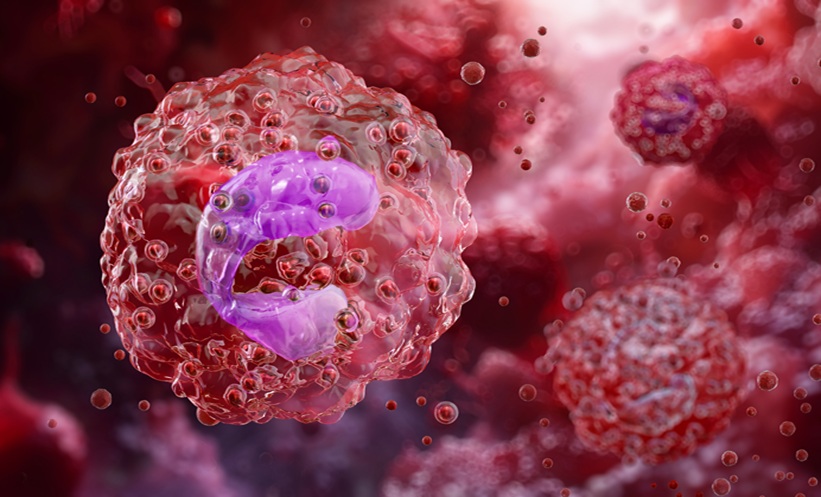Gothic architecture and cobbled backstreets created the breath-taking backdrop for this year’s European Academy of Allergy and Clinical Immunology (EAACI) Congress. Portugal’s bustling capital city of Lisbon hosted >7,000 delegates for the 5-day event that has become a staple in the budding allergist and immunologist’s calendar. The EMJ team were spoilt for choice in Lisbon this year, with a cornucopia of ground-breaking research, thought-provoking sessions, >60 symposia, and a wealth of abstract and poster presentations on offer.
Prof Luis Delgado, Vice President of Education and Specialty for EAACI, discussed Lisbon and EAACI’s rich histories in the opening ceremony, highlighting the many developments within the fields of allergy and immunology, such as enhancements in the mapping of allergy structure and biological treatments. This year’s event was no different in its ambitions to advance knowledge in every corner of the field. There was a plethora of abstract and poster presentations and we have compiled a range of abstracts that were of particular interest. Summaries of these select abstracts can be found inside EMJ Allergy and Immunology 4.1‘s congress review, penned by the authors themselves to give you a first-hand insight into the abstract presentations.
Prof Leif Bjermer’s thought-provoking session looked at the barrier of respiratory diseases, particularly asthma, for aspiring athletes. Prof Bjermer outlined how the very nature of athleticism puts the lungs under additional pressure, leaving athletes more susceptible to respiratory diseases. He warned against immune remodelling and suppression, activities that can leave athletes in a vulnerable position. The session ended on a positive note, encouraging enjoyment and a focus on the positive aspects of exercise while avoiding stress.
This edition also brings you a summary of a EAACI Position Paper that studies the prevalence of allergology specialty and sub-specialty in Europe and nearby countries, as well as the level and availability of care for allergic disease in these countries. The write-up also discusses a SWOT analysis carried out in the surveys created by the position paper authors to gain insight into the perceived strengths, weaknesses, opportunities, and threats throughout these countries surrounding the speciality of allergology. The paper calls for further training opportunities and freedom of movement for allergologists to ensure the profession attracts young talent and better facilitates a high level of allergy care.
The congress was packed full of fascinating sessions, targeting poignant and topical issues over the 5-day period, while enabling the sharing of knowledge to create a better future for the care and treatment of allergy. We already have our sights set on the next annual congress for EAACI, which will be held in the historical city of London, UK. We hope to see you all there for what is sure to be another fantastic event opening a gateway to the vital sharing of knowledge within allergy and immunology. In the meantime, please sit back and enjoy our highlights from the incomparable congress that was EAACI 2019.
Assessment of Oral Immunotherapy for Paediatric Allergy
PAEDIATRIC food allergy affects 8% of children in Westernised countries and is characterised by medical and social implications for the child that are of utmost importance to the healthcare community. Much focus is given to the prevention of severe reactions in this vulnerable demographic through education and limiting of high-risk exposure scenarios, and deservedly so. However, now more than ever there has been an increased focus towards developing therapeutic means to alleviate or eliminate paediatric allergy.
Prof Montserrat Alvaro Lozano from the Sant Joan de Déu Children’s Hospital in Barcelona, Spain, provided her expert insight into the use of oral immunotherapy for the treatment of allergic children during one of EAACI’s pros and cons sessions. This involves the desensitisation of the child’s allergy through periodic exposure of initially small amounts of the specific allergen in the child’s food. Through gradual increases of dosage and clearance of allergic symptoms, an optimal end goal can feasibly be achieved in which an adequate nutritional state is attained, and the child’s social life is markedly improved.
Prof Lozano was open in her admiration and optimism concerning this therapeutic approach, but dutifully highlighted to the audience that there is still much work to be done towards making immunotherapy the standard of care. Due to the high-risk and intensive nature of the treatment, not to mention the accuracy with which the treatment must be administered, standard practice is for it to be performed in tertiary centres with experienced medical personnel and appropriate resuscitation facilities available. This is to prepare for adverse events, which are still frequent and can be severe.
Because of these practical and logistical considerations, Prof Lozano was of the opinion that we are currently not at a stage to widely offer immunotherapy for allergic children in the clinic. Speculating on the future of paediatric allergy treatment, she commented on the exciting prospect of developing immunotherapy further to improve efficacy and safety, and also using it to identify biomarkers in patients. Through identifying these biomarkers for a good or bad response, treatment can be tailored to the individual and hopefully lead to noticeable improvements across the paediatric allergy landscape.
mAPPing the New World of Allergy
IN THE CURRENT digital world, mobile phones assist us in numerous aspects of our daily life, and are even helping us to monitor our health, so it is no surprise that applications can now be used to assist precision medicine approaches. All fields of medicine will benefit from the use of these technologies, including allergy and clinical immunology. A new avenue for controlling allergic rhinitis and allergy by mHealth technology was presented at the EAACI Congress 1st-5th June 2019.
Not only will patients benefit directly from the installation of these technologies into healthcare, but so will research, epidemiology studies, and general standard of care. Patients will gain independence and control of their disease, in addition to improved communication with their doctors. The attending doctor will be able to keep a photographic history of the disease, analyse longitudinal data to retrieve suggested diagnosis and treatment, and adjust treatment to ensure it remains optimal.
Multiple mobile applications for allergic disease have already been developed and are being used by patients every day. Mobile Airways Sentinel Network uses a visual analogue scale for nose, eye, and asthma symptoms to link allergy to work impairment. Patients with pollen allergies can use pollen diaries to compare the different seasons and aerobiological particles to identify the possible allergen or forecast worsening of pollen allergy symptoms. Applications can even advise those with food allergies in the selection of allergy-free foods.
“Apps are instantly helpful – which is what someone with a severe allergy needs. Sadly, we have seen that people can’t always rely on restaurants and cafes to keep them safe, so an App puts the control back into the hands of the patient,” says Leah Ryz, 38, Hove, UK, who uses a mobile application to scan allergen-free foods.
Advice for Aspiring Elite Athletes
BECOMING a gold medal Olympian or scoring the winning goal in the World Cup final are the kinds of dreams held by millions of young people. Yet many of those who strive to make this ambition of being an elite athlete a reality will be stopped in their tracks due to the development of respiratory problems such as asthma. In a poignant session at this year’s EAACI Congress, Prof Leif Bjermer, Respiratory Medicine and Allergology, Lund University, Lund, Sweden, offered advice on how to minimise the chances of these issues occurring, using the latest research findings in this area.
Prof Bjermer began with a sombre message for a significant number who hold aspirations of becoming an elite sportsperson; your natural genetic make-up can make it very difficult to succeed at such a high level. In particular, if your maximum level of oxygen consumption (VO2) is not high enough, your body is probably unlikely to be able to cope with the demands an elite sportsperson must endure. He highlighted a case report of an aspiring cross-country skier who was initially very successful at junior level. Sadly, she began to repeatedly develop respiratory infections. The source of these problems was her limited VO2 maximum, at 54 mL/kg/min: not high enough to compete at an elite level, which meant her respiratory system struggled to cope with the intensity of training. “I see this quite often where there’s someone who can never become an elite athlete with that maximum optimal uptake. They are depressed, they don’t understand why they can’t succeed, but the problem is they just do not have the ability,” commented Prof Bjermer.
The risk of developing asthma is particularly strong in those undertaking endurance sport, in which high levels of oxidative stress are placed on the airways. Prof Bjermer highlighted studies of marathon runners in which evidence of damage and stress to the airways have been gathered, the latter indicated by a higher degree of lipid peroxidation and vitamin E turnover. Therefore, minimising oxidative stress is critical in people for sports such as marathon running. Studies in mice models have shown the potential for antioxidative drugs to decrease muscular fatigue during strenuous exercise and increasing vitamin E levels appears to reduce neutrophilic inflammation and mucus production. Whether such approaches can be applied in a clinical setting remains to be seen.
Endurance sport can also make people especially vulnerable to respiratory infection, with lower neutrophil activity leading to reduced immune capacity. There is a period following intense exercise in which people are immunosuppressed. It is crucial for aspiring athletes to therefore take steps to avoid infection during this period. Prof Bjermer outlined how elite sports teams often implement strict measures to prevent scenarios where infections can be caught, such as staying in a separate hotel, not talking to journalists, and not shaking hands with anyone. Clinical trials have also demonstrated the efficacy of some medications in reducing the chances of getting a respiratory infection, including taking probiotic supplements. He added: “My advice is to prevent respiratory infection and immune remodelling and most importantly of all, if you feel you are underweight or have a cold, don’t stress yourself, don’t compete: the best training activity you can do is to stay in bed.”
Prof Bjermer later went on to emphasise the importance of maintaining a healthy nose. This should be an ongoing priority for aspiring young athletes, according to Prof Bjermer, because nose problems are more frequent compared to the general population in athletes in any form of sport and setting, indoor or outdoor. “We know that if you improve nasal patency and nasal ventilation, it will help you to get better matching of the ventilation perfusion between the lower airways, thereby improving performance,” he stated.
Finally, Prof Bjermer put the whole issue into perspective during his closing remarks, with advice for young athletes, coaches, and medical professionals alike: “My final advice is to enjoy what you are doing. Doing endurance exercise is a health hazard: you face the risk of developing asthma. But when you balance all the positive effects of exercise it’s worth it. But you need to face it, and I think as leaders who are dealing with young athletes in their growing career, it’s really important to protect them from being over-stressed.”
World Environment Day
WORLD Environment Day, a United Nations initiative supported by EAACI, this year focussed on the topic of air pollution and its impact on global health, climate change, and asthma. A EAACI press release dated 5th June 2019 gave more detail on connections between air pollution and allergic diseases, as well as the ways in which the EAACI is working to reduce the incidence of allergic diseases caused by air pollution.
Ever since the industrial revolution, allergic and respiratory diseases have been on the rise, with multi-faceted causes and complex pathogeneses. The increase in emissions of greenhouse gases has led to more CO2 in the atmosphere and higher temperatures across the globe. “Depending where you live, higher temperatures may result in more plant growth. A shift in allergen exposure from pollen is to be expected, the direction depends on where you live,” explained Dr Jeroen Buters, Technical University of Munich, Munich, Germany, and past Chair of the EAACI Working Group on Aerobiology and Pollution.
However, according to EAACI, CO2 is not the only gas to make pollen more allergenic. Birch and ryegrass pollen that had an increased exposure to traffic pollutants like nitrogen oxides, ozone, and diesel exhaust particles was found to have a higher volume of allergens than pollen in urban parks. In addition, rates of asthma are increased by exposure to traffic fumes and prenatal exposure can impact the development of the respiratory system in children.
“Exposure to particulates from diesel vehicle emissions is linked to asthma and allergies. Although everyone is susceptible to diesel pollution, children, the elderly, and individuals with pre-existing respiratory conditions are the most vulnerable. As vehicles equipped with advanced diesel emissions controls will enter the market, it will be important to ensure that emission levels are maintained throughout the life of the vehicle by periodic testing,” said Isabella Annesi-Maesano, Institut National de la Santé et de la Recherche Médicale (INSERM).
EAACI’s commitment to reducing these challenges is set out in the 2018 White Paper on Research, Innovation, and Quality Care.1 Therein, EAACI suggested “Exposome-focused projects are needed to examine the complex interplay of environment and genetics to determine the most cost-effective interventions for reducing the risk of allergic disease,” adding “Once key exposures and potential interventions are identified, a comprehensive approach among clinicians, patients, healthcare organisations, insurance providers, government agencies, and urban planners must be undertaken to establish cost-effective primary and secondary prevention strategies to reduce these risks and promote wellness.”
eHealth: Striding for Digital Healthcare
IN THE DIGITAL age, there is a smartphone app for just about everything; it is time for healthcare to catch up and embrace the digital shift. eHealth is enabling this change: taking strides into the app world to offer patients the possibility to record their data on their smartphone, tablet, or wearable device. eHealth has numerous benefits, including at-home monitoring, reliable data collection through standardised recording, and a cut down on unnecessary GP appointments, to name just a few.
The EAACI opening ceremony session on eHealth, Mobile Health Technologies in Allergy Care, explores the digital universe of eHealth, and the many possibilities it presents. eHealth refers to digital tools relating to healthcare and offers software solutions that can be ran on a mobile device and can often connect with wearables. There are a range of stakeholders, most notably patients and doctors, many of whom can see the benefit of eHealth; the session reviewed a questionnaire surveying 1,200 physicians across 9 specialties that showed that these doctors could see the potential that digital solutions offer for their patients.
The session also discussed the World Health Organization (WHO), which has published guidelines around digital health solutions, aiming to assist countries who need to create eHealth policies. But it is not as simple as just creating a policy; as options expand and evolutions occur, the requirements for a good policy become more complex. It is important to remember that, as with the entire digital world, eHealth changes every day, feeding into the complexities that come with policy creation.
One challenge to consider is the high prevalence of people downloading apps and then not using them. These healthcare apps would have ~to cause minimal disturbance to the patients’ day-to-day life and be immediately beneficial to keep usage rates high. The world of eHealth offers great potential for patients and doctors alike, but it is critical that barriers such as this are faced to ensure that this digital avenue can be explored to its highest potential.
Bacterial Infection Linked to Food Allergy in Children with Atopic Dermatitis
DURING the Presidential Symposium on Immunomodulation in Food Allergy, held at this year’s congress, findings from an international collaboration were presented in which Staphylococcus aureus bacteria colonisation was shown to be closely correlated with likelihood and persistence of food allergy in children with atopic dermatitis (i.e., eczema). Prof George du Toit from King’s College London, London, UK, was on-hand to talk about the findings.
S. aureus infection has previously been associated with severe eczema, a dermatological condition which itself is a risk factor for food sensitisation or allergy. The research group reasoned that there may exist a direct link between S. aureus status and food allergy through the regulatory influence of eczema severity. Participants from the Learning Early About Peanut Allergy (LEAP) study who had eczema were assessed for severity of their condition and had skin/nasal swabs taken and analysed.
Across the cohort, bacterial colonisation was significantly associated with eczema severity, except at age points 12 and 60 months where a deterioration in severity was associated. However, skin colonisation correlated with high levels of hen’s egg white and peanut sIgE at any time point compared to those without colonisation, a finding that was independent of eczema severity. A positive correlation was also observed with persistence of the food allergy to age 5 or 6 years, a point by which the majority of allergic children have become desensitised. This effect was also independent of eczema severity.
Dr Olympia Tsilochristou, lead author, commented: “We yet do not know the exact mechanisms that lead from atopic dermatitis to food allergy; however, our results suggest that Staphylococcus aureus could be an important factor contributing to this outcome.” Another of the contributors suggested that further longitudinal studies involving advanced techniques and interventional strategies aimed at eliminating S. aureus in early stages of life might hold potential for determining the environmental factors that aid progression of eczema and food allergy.







